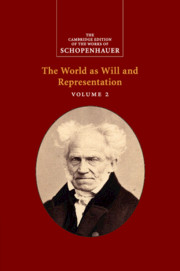Chapter 35 - On the Aesthetics of Architecture
Published online by Cambridge University Press: 30 June 2022
Summary
In conformity with the derivation we gave in the text of the purely aesthetic aspects of architecture from the lowest levels of the objectivation of the will or of nature, whose Ideas it wants to make more clearly intuitive, the single and constant theme of architecture, is supports and loads, and its fundamental principle is that there should be no load without sufficient support, and no support without a proportionate load, and thus the relation between the two must be precisely the appropriate one. The theme is put into operation most purely in columns and entablature: and thus the arrangement of columns has become the thorough-bass, as it were, of the whole of architecture. In columns and entablature, supports and loads are completely separate; so that the effect they have on each other and their relation to each other becomes obvious. Any simple wall will already make use of supports and loads, only here the two are still blended together: everything is both support and load, and hence there is not an aesthetic effect. This only appears when they are separated, and is proportional to the degree of separation. There are many intermediary stages between a row of columns and a plain wall. Even when the wall of a house is broken simply by windows and doors, one can at least try to present this separation through flat, protruding pilasters (antes) with capitals instead of moulding, even painting the capitals on if need be: this will indicate, in at least some way, the entablature and arrangement of pillars. Actual pillars, as well as consoles and supports of different sorts give an even greater reality to the pure separation of support and load to which architecture aspires. In this respect, the vaulted ceiling with pillars stands next to the column with entablature, but as a distinctive construction in its own right that does not merely imitate this latter. The aesthetic effect of the vaulted ceiling does not of course come close to that of the column and entablature, because in the former case the support and load are not purely separated but rather merge together.
- Type
- Chapter
- Information
- Schopenhauer: The World as Will and Representation , pp. 428 - 435Publisher: Cambridge University PressPrint publication year: 2018

